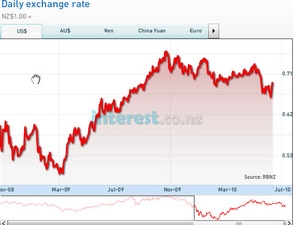
 By Mike Jones*
By Mike Jones*
The combined effects of an RBNZ interest rate hike and a modest recovery in global risk appetite propelled NZD/USD to 3½ week highs above 0.6900 last week. After twelve months of stagnation, at a very low level, the RBNZ last week began the process of returning interest rates to a neutral setting.
The OCR was raised to 2.75% from 2.50% in what is expected to be the first move in a series, which will eventually see the rate push up, first, to neutral and then, probably, a little to the tighter side of such. While it’s tempting to assume last week’s recovery in the NZD was all about the RBNZ and the NZD’s widening yield advantage, it’s worthwhile noting that NZ-US 3-year swap spreads actually ended the week bang-on where they started around 310bps.
In contrast, last week’s 2.9% increase in NZD/USD had more to do with an improvement in the global backdrop. Indeed, our global risk appetite index (which has a scale of 0-100%) finished the week up 5%, at 39%. Upbeat Australian and Chinese data restored faith in the ability of Asian economies to lead the global economic recovery. Meanwhile, an apparent stabilising in the European sovereign debt crisis underscored a tentative recovery in ‘risky assets’.
The S&P500 rose 2.5% over the week, the CRB index (a broad index of commodity prices) jumped 2.8%, and “safe-haven” currencies like the USD and JPY were sold in favour of “growth-sensitive” currencies like NZD and AUD.
This week’s local data calendar has a clear household sector theme to it. Monday’s retail figures for April will probably be the most anticipated (we’re picking a 0.4% drop), Tuesday will no doubt bring another flat batch of REINZ housing data, and the final piece of domestic data comes Thursday, with the latest ANZ-RM reading of consumer confidence. Indicative of where the focus for the NZD lies at present, the correlation between the S&P500 and NZD/USD has increased to 90%, from around 40% in April.
Over the same period, the correlation between NZD/USD and NZ-US 3-year swap spreads has fallen from 65% to below 0%.
So it remains the case that the fortunes of the NZD/USD are most closely tied to investors’ risk appetite (with equity market performance one barometer of such). According to our short-term NZD/USD valuation model, a rise in our risk appetite index back towards 50% (all else being equal) would be consistent with a NZD/USD around 0.7050. As such, for the NZD to extend its recent gains we’ll have to see upcoming global data continue to restore optimism about the global recovery. In the short-term, we suspect dips will be limited to 0.6750.
Majors
The USD index pared some of last week’s losses on Friday, to end the week down 0.8%. Friday’s USD gains were most marked against GBP, EUR and JPY.
Despite the welcome distraction of the start of the Football World Cup, there was plenty to keep markets occupied on Friday.
A German FT article suggesting the EU is worried about a Spanish Bankruptcy initially kept risk appetite under pressure, and dragged EUR/USD to an overnight low of nearly 1.2050.
In a similar vein, a warning from Japanese PM Kan that Japan risks default if growing public debt is ignored underscored USD/JPY’s drift up to almost 91.70. However, early nervousness was soon shrugged off as more evidence came to light of a stabilisation in the European debt crisis. Italy’s sovereign bond auction drew solid demand, following good results from last week’s debt sales in Belgium, Portugal and Spain.
ECB Board member Stark also said the Eurozone’s problems were “less severe than market reaction suggests”. Italian and Spanish 1-year CDS spreads both narrowed around 60bps last week. A report from ratings agency Moody’s appeared to calm fears about the European banking sector.
The report suggested European banks can absorb “severe” losses on their exposure to Greek, Portuguese, Spanish, and Italian assets.
As a result, most European equity indices ended the night in the black, and the EUR/USD recovered to around 1.2100. US equities were whipsawed by conflicting reports on the state of the US consumer.
May retail sales were awful (-1.2% vs. +0.2% expected), but some offset was found from the buoyant University of Michigan consumer confidence survey (75.5 vs. 74.5 expected). After spending most of the night in negative territory, the S&P500 and the Dow both posted gains of around 0.4%, helping underpin further recovery in investors’ risk appetite on Friday.
Despite improving sentiment toward ‘growth-sensitive’ currencies, GBP was hurt by disappointingly weak industrial production and manufacturing data. GBP/USD fell over 2 cents to nearly 1.4500 and EUR/GBP rebounded 1.3%, having earlier hit 19-month lows around 0.8200.
Looking ahead, this year’s near 13% rally in the USD index is starting to look exhaustive.
For downside pressure to remain on the USD, we’ll need to see this week’s data continue to restore faith in the global economic recovery. In this regard, keep an eye on European industrial production and employment data, UK May retail sales, and US housing starts and building permits data for May.
The SNB and the BOJ also meet this week and the RBA’s June Board minutes will also be worth a watch.
* Mike Jones is part of the BNZ research team. All its research is available here.
We welcome your comments below. If you are not already registered, please register to comment.
Remember we welcome robust, respectful and insightful debate. We don't welcome abusive or defamatory comments and will de-register those repeatedly making such comments. Our current comment policy is here.